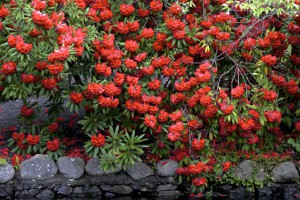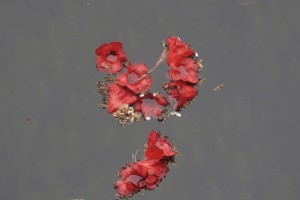Monday
Arts and PoetryLessons Learned from Being Underwater
Finding Balance in a Contemplative Life
by Julie Dubose
Recently, I had the great pleasure of returning to Royal Roads University in Victoria, B.C. with Michael Wood to teach Opening the Good Eye and Making Contact, the first two courses in our contemplative photography curriculum. We felt very welcome and cared for, and the university campus, nestled in an old growth forest by the ocean side, was very quiet and peaceful.
I want to tell you about what happened to me there and what I am feeling about it because it was the type of thing that cannot be ignored, and I am paying attention. I would like to bring it to your attention too, because a lesson worth noting is possibly worth communicating.
I have an iPad Mini, which during the first course slipped out from where I had it tucked under my arm and hit the concrete sidewalk. The glass had hairline cracks, but the iPAD still worked fine. That’s a repair of $150. Then one day later I dropped my iPhone, which landed on one of the corners and caused hairline cracks in the glass. That’s another $150 to repair.
I was pretty amazed by all of this, since I have never had any damage to any device I have owned since I first bought a mobile phone, and you can imagine how long ago that was. It is ancient history, sort of like the day I was born.
I mentioned these events to our class, and someone said, ”I guess the camera is next.” I shuddered and wished those words had never been spoken.
 The next day I was moved by a discussion about Kaii Higashiyama’s paintings, and I decided to visit the Japanese Gardens at the end of the day. I felt completely absorbed and peaceful as my eye and mind swam in a feast of rich, multi-layered perceptions. I was just soaking it up. I made my way to the pond and noticed a brilliant red bush of blooms, some of which had fallen to the water’s surface, which was a rich gray hue.
The next day I was moved by a discussion about Kaii Higashiyama’s paintings, and I decided to visit the Japanese Gardens at the end of the day. I felt completely absorbed and peaceful as my eye and mind swam in a feast of rich, multi-layered perceptions. I was just soaking it up. I made my way to the pond and noticed a brilliant red bush of blooms, some of which had fallen to the water’s surface, which was a rich gray hue.
It was magnetized and felt drawn to move closer to see, and found that I couldn’t quite get close enough to photograph what I was seeing because of many plant shoots sprouting up along the water’s edge. I leaned in and stretched forward as fully as I could, and then I felt myself floating head first down into the water.
It was the perfect Making Contact experience. First I hit the water and experienced the sharp edge of entrance. It was definitely shocking, but in a good way. My entire body was enlivened and stimulated by the sensation of cold, silken wetness. As I felt myself fully submerged beneath the water’s surface, somehow instinctively I was bringing myself up. It seemed to be all happening at once, and I had no thought, only the sensation of swimming in the experience. All my senses were very acute and I felt very alive.
I felt along the underwater wall of the pond and grabbed one of many protruding, angular rocks, pulling myself to the water’s edge. The rocks were rough and easy to hold onto, although I couldn’t find a foothold. My head was now above the water and I hung on to the side with one hand. My first action was to lift my Lumix G5 off of my neck and put it on dry land. My second action was an assessment of the temperature of the water, which was cold, but not freezing. In fact, it was refreshing. I satisfied myself that there was no imminent danger of hypothermia. Then I yelled out for Michael, who fortunately was not out of hearing range. He miraculously appeared immediately in front of me offering assistance. After he helped me get out, I took stock as I looked down at my legs and felt my wet clothes clinging to my skin. I was soaking wet from the top of my head to my feet and covered in pond scum. In my left pocket I had my very wet Canon S100, and in my right, my Leica 45mm prime lens. I had been carrying all my various camera equipment, just in case.
Upon examination, all my cameras were dead. Michael used the hair dryer as I looked anxiously over his shoulder, and hoped the next day might bring good news. But the lenses had water inside them and the Lumix had been turned on when it hit the water and was totally dead. My Canon also showed no signed of life. In the end, all my instruments of expression were lifeless and beyond help.
I’m not that slow to figure out there seems to be a theme running through these events. All of my “essential” portable devices and cameras have been damaged or destroyed over a period of four days. Something is definitely up, and although I may never have confirmation that I really understand the whole picture, I have to really examine what is happening so that hopefully I won’t have to replace any more dead equipment.
After some contemplation, I can only say that there may be an issue of internal balance within me that is trying to correct itself. I may be spending more time using and depending upon technology than is necessary, or even beneficial, to anyone.
Our ability to teach Miksang benefits enormously from the technological advancements that have happened in recent years. But fundamentally, what is most important is the state of mind, the openness, and the ability to experience unconditional perception.
I can’t do that while staring at my cell phone, iPad, or through my camera viewfinder. And the use of my camera to express my perceptions is secondary to having a direct perception in the first place.
It is more important for me that I take my time and live my life in an undistracted way, however I can. It matters to me that my experience is deep and still, and that I can communicate the essence of what I can understand through my words and images.
This is my point of balance. First comes the primary fundamental situation of going deep in my experience from moment to moment. From that comes everything else. If I stray from this way of being, I am pretty sure that I’m going to be looking for another good dunking. And no doubt, once again, I’ll be the better for it.
~~
 Julie DuBose has been studying and practicing Miksang Photography for 13 years. She is one of the Principal Miksang Instructors, presents all Miksang Levels internationally and lives in Boulder, Colorado. Julie is the Founder of the Miksang Institute for Contemplative Photography. She is also the author of: “Effortless Beauty: Photography as an Expression of Eye, Mind and Heart”
Julie DuBose has been studying and practicing Miksang Photography for 13 years. She is one of the Principal Miksang Instructors, presents all Miksang Levels internationally and lives in Boulder, Colorado. Julie is the Founder of the Miksang Institute for Contemplative Photography. She is also the author of: “Effortless Beauty: Photography as an Expression of Eye, Mind and Heart”





